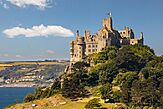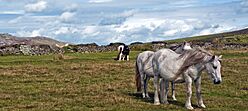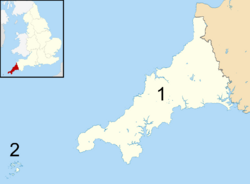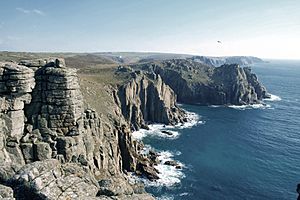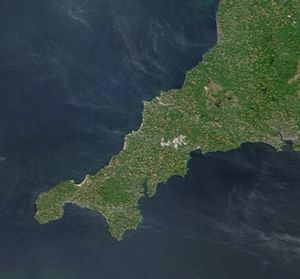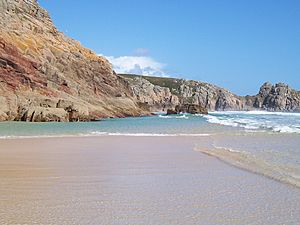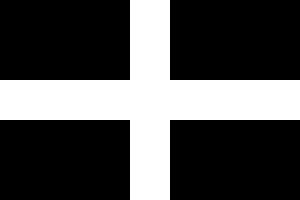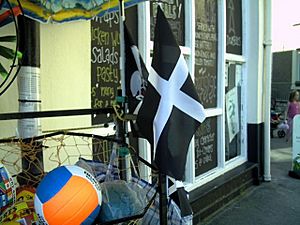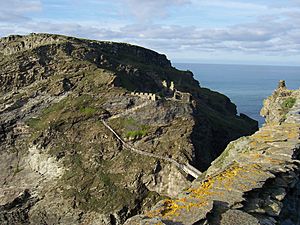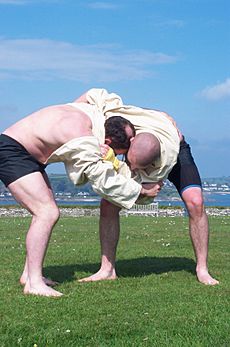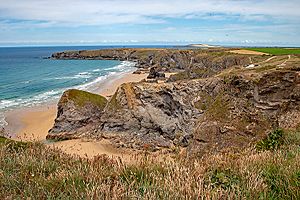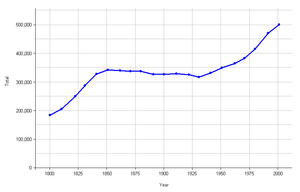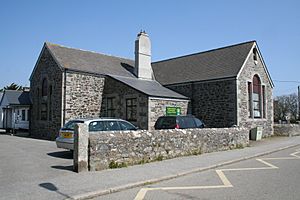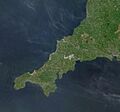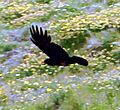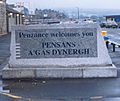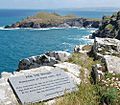Cornwall facts for kids
Quick facts for kids
Cornwall
Kernow (Cornish)
|
|||||||||||||||||||||||||||||||||||||||||||||||||||||
|---|---|---|---|---|---|---|---|---|---|---|---|---|---|---|---|---|---|---|---|---|---|---|---|---|---|---|---|---|---|---|---|---|---|---|---|---|---|---|---|---|---|---|---|---|---|---|---|---|---|---|---|---|---|
|
|
|||||||||||||||||||||||||||||||||||||||||||||||||||||
|
|||||||||||||||||||||||||||||||||||||||||||||||||||||

Cornwall shown within England
|
|||||||||||||||||||||||||||||||||||||||||||||||||||||
| Sovereign state | United Kingdom | ||||||||||||||||||||||||||||||||||||||||||||||||||||
| Constituent country | England | ||||||||||||||||||||||||||||||||||||||||||||||||||||
| Region | South West England | ||||||||||||||||||||||||||||||||||||||||||||||||||||
| Established | Ancient | ||||||||||||||||||||||||||||||||||||||||||||||||||||
| Time zone | UTC±00:00 (Greenwich Mean Time) | ||||||||||||||||||||||||||||||||||||||||||||||||||||
| • Summer (DST) | UTC+01:00 (British Summer Time) | ||||||||||||||||||||||||||||||||||||||||||||||||||||
| Members of Parliament | 6 MPs | ||||||||||||||||||||||||||||||||||||||||||||||||||||
| Police | Devon and Cornwall Police | ||||||||||||||||||||||||||||||||||||||||||||||||||||
|
|||||||||||||||||||||||||||||||||||||||||||||||||||||
Cornwall (which is Kernow in the Cornish language) is a beautiful county in South West England. It's known as one of the Celtic nations and is the homeland of the Cornish people. Cornwall is surrounded by the Atlantic Ocean to the north and west, and the English Channel to the south. To its east is the county of Devon. The largest town is Falmouth, and the main city is Truro.
Cornwall is mostly a rural area, meaning it has lots of countryside. It covers about 3,562 square kilometres (1,375 square miles) and has a population of around 568,210 people. After Falmouth, the biggest towns are Penzance, Newquay, St Austell, and Truro. For local government, most of Cornwall is managed by one main council, while the Isles of Scilly have their own special local authority. Some people in Cornwall want it to have more control over its own decisions within the United Kingdom.
Cornwall is the most western part of the South West Peninsula. Its coastline has tall, steep cliffs. On the south side, there are several river inlets called rias, like those at the mouths of the Fal and Fowey. Lizard Point in Cornwall is the southernmost spot on Great Britain. A large part of the county is protected as the Cornwall National Landscape. This area also includes Bodmin Moor, a high, rocky moorland. Cornwall has many short rivers; the longest is the Tamar, which forms the border with Devon.
Cornwall had a small Roman presence a long time ago. Later, it was part of a British kingdom called Dumnonia. From the 7th century, the Britons in the South West often fought with the growing Anglo-Saxon kingdom of Wessex. By the time of the Norman Conquest, Cornwall was part of England, but it kept its unique culture. During the Middle Ages and Early Modern Period, Cornwall became famous for its tin mining and became a duchy in 1337. In the Industrial Revolution, tin and copper mines grew, then later declined. China clay mining then became a major industry. Railways were built, which helped tourism grow in the 20th century. The Cornish language almost disappeared by the end of the 18th century, but people are now working to bring it back.
Contents
The Name of Cornwall
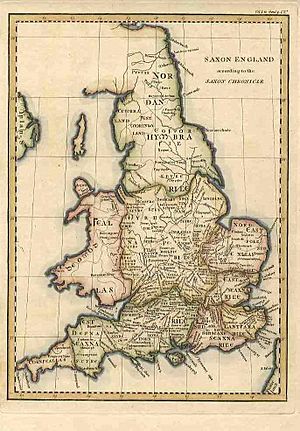
The name "Cornwall" comes from two different parts:
- "Corn-" comes from an old Celtic word meaning "horn" or "headland". This probably refers to Cornwall's shape, which sticks out like a horn into the sea. There might also have been an ancient group of people called the Cornovii who lived here.
- "-wall" comes from an Old English word, wealh, which meant "foreigner" or "Brittonic-speaker". This is the same word that gave us "Welsh".
In the Cornish language, Cornwall is called Kernow. This name comes from the same old Celtic root as "Corn-".
History of Cornwall
Ancient Cornwall: From Stone Age to Romans
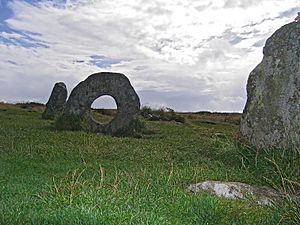
Humans first lived in the area now known as Cornwall after the last Ice Age. People continued to live here through the Neolithic (New Stone Age) and Bronze Age periods. During the Late Bronze Age, Cornwall was part of a large trading network that stretched across parts of Ireland, England, Wales, France, Spain, and Portugal.
During the British Iron Age, Cornwall was home to Celtic-speaking people called the Britons. Their language eventually grew into different languages like Cornish, Welsh, and Breton.
The first written mention of Cornwall comes from a Greek historian named Diodorus Siculus in the 1st century BC. He wrote about the people of "Belerion" (which is Land's End) who were skilled at mining tin. They traded this tin with merchants who took it across to France and then to the Mediterranean Sea. Tin was very important in the Bronze Age because it was needed to make bronze.
During the time of Roman Britain (the first four centuries AD), Cornwall was quite far from the main Roman areas. However, the Romans did have some forts here, and a Roman-style villa was found at Magor Farm. After 410 AD, Cornwall seems to have been ruled by local British leaders, as part of the kingdom of Dumnonia. One famous figure from this time is "King" Mark of Cornwall, who appears in the legends of Tristan and Yseult and is sometimes linked to King Arthur.
Many Celtic saints, like Petroc and Piran, came to Cornwall in the 5th and 6th centuries. They helped strengthen Christianity in the area.
Conflicts with Wessex
In 577 AD, a battle separated Dumnonia (including Cornwall) from Wales. After this, the people of Dumnonia often fought with the growing English kingdom of Wessex. In 682, the King of Wessex, Centwine, pushed the Britons "as far as the sea." By the 880s, Anglo-Saxons from Wessex had started to own land in north-eastern Cornwall.
Around 924-939 AD, King Athelstan of England set the Tamar River as the border between the English and Cornish people. He also brought back a separate Cornish Bishop. Over time, relations between Wessex and the Cornish improved.
Norman Period and Tin Mining

After the Norman Conquest in 1066, most of the land in Cornwall was given to new Norman and Breton noble families. The Bretons were also descendants of Britons who had moved to what is now Brittany in France.
Later, a new Cornish-Norman ruling class emerged. They spoke Norman French, Breton-Cornish, Latin, and eventually English. They became involved in the special laws for tin miners. The Cornish language continued to be spoken and developed into its own distinct language.
Stannary Parliaments
The stannary parliaments and courts were special law-making and legal groups for tin miners in Cornwall. These special rules showed how important the tin industry was to England's economy during the Middle Ages. Tin miners had special rights and were usually only judged by these stannary courts.
Piracy and Smuggling
Cornwall was known for wreckers who took goods from ships that crashed on its rocky coast. During the 17th and 18th centuries, Cornwall was also a major area for smuggling, which means illegally bringing goods into the country.
Physical Geography
Cornwall is at the very tip of the south-west peninsula of Great Britain. This means it gets the full force of the winds from the Atlantic Ocean. Its coastline is mostly made of strong rocks, which create tall cliffs in many places. Cornwall shares a border with only one other county, Devon. This border is mostly formed by the River Tamar, and in the north, by the Marsland Valley.
Coastal Areas
The north and south coasts of Cornwall are quite different. The north coast, facing the Celtic Sea (part of the Atlantic Ocean), is more exposed and wild. The High Cliff, between Boscastle and St Gennys, is the tallest sheer-drop cliff in Cornwall at 223 meters (732 feet). Popular beaches on the north coast include Bude, Polzeath, Watergate Bay, Perranporth, Fistral Beach in Newquay, and St Ives.

The south coast, sometimes called the "Cornish Riviera," is more sheltered. It has several wide river mouths that offer safe places for boats, such as at Falmouth and Fowey. Beaches on the south coast often have coarser sand and pebbles. The charming fishing villages of Polperro and Looe are also popular with tourists.
Inland Areas
The middle of Cornwall has a spine of high, open land running from east to west. This area has several granite outcrops, like Bodmin Moor, which is the highest point in Cornwall. These granite areas are part of a larger rock formation that also includes Dartmoor in Devon and the Isles of Scilly.
When the granite pushed into the surrounding rocks, it created many minerals. This made Cornwall one of the most important mining areas in Europe until the early 20th century. People believe tin was mined here as early as the Bronze Age. Copper, lead, zinc, and silver were also mined. The granite also led to large deposits of China Clay, especially north of St Austell, which is still an important industry today.
The high moorlands are surrounded by more fertile farmland, mostly used for grazing animals. Near the south coast, deep, wooded valleys provide sheltered spots for plants that like shade and a mild, moist climate.
Lizard Peninsula
The Lizard Peninsula has unusual geology. It's the only place in mainland Britain where you can find an ophiolite, which is a piece of oceanic crust now on land. Much of the peninsula is made of dark green and red serpentinite rock, which forms amazing cliffs, like at Kynance Cove. This rock also creates a very infertile soil, which is home to rare plants, such as the Cornish Heath, the county flower.
Towns and Travel
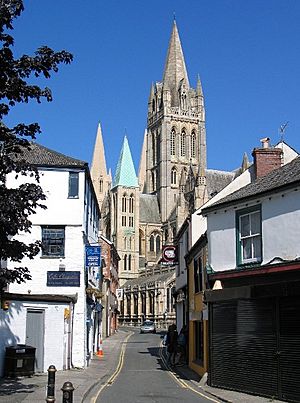
Cornwall's only city is Truro, which is also where the council headquarters are located. Nearby Falmouth is a well-known port. St Just in Penwith is the westernmost town in England. St Ives and Padstow are now small ports that focus on tourism and leisure. Newquay on the north coast is a popular surfing spot and is also growing in aviation-related industries.
Camborne is the largest town in Cornwall and, along with Redruth, forms the biggest urban area. Both towns were important centres for tin mining in the 19th century. St Austell is also larger than Truro and was the centre of the china clay industry.
Major roads connecting Cornwall to the rest of Great Britain include the A38 road, which crosses the River Tamar at Plymouth via the Tamar Bridge. The A30 road connects Cornwall to the M5 motorway at Exeter and goes through many Cornish towns like Bodmin, Truro, and Penzance. The Royal Albert Bridge, built by Isambard Kingdom Brunel, is another important link for trains.
The Isles of Scilly can be reached by ferry from Penzance or by plane from St Mary's Airport. There are regular flights between St Mary's and Land's End Airport and Newquay Airport.
Nature and Climate
Plants and Animals
Cornwall has many different natural habitats, including land and sea environments. One special species that needs protection here is the Reindeer lichen.
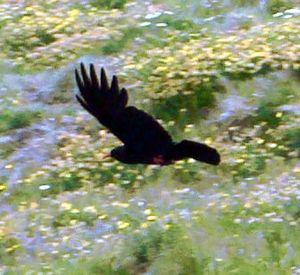
Climate
Cornwall has a mild Oceanic climate, with gentle winters and cool summers. It has one of the mildest and sunniest climates in the United Kingdom. This is because it's surrounded by the ocean and influenced by the Gulf Stream, a warm ocean current. Average temperatures in Cornwall range from about 11.6°C (52.9°F) on the Isles of Scilly to 9.8°C (49.6°F) in the central uplands. Frost and snow are very rare near the coast.
Cornwall gets more than 1,541 hours of sunshine each year. The moist, mild air from the southwest brings more rainfall than in eastern Great Britain, usually between 1051 to 1290 mm (41.4 to 50.8 inches) per year. Extreme temperatures are rare, but strong storms and floods can happen. Due to climate change, Cornwall might experience more heatwaves, droughts, coastal erosion, and stronger storms.
Culture of Cornwall
Language
Cornish Language
Cornish is a Brythonic Celtic language, closely related to Breton and Welsh. It stopped being spoken as a first language by most people in the late 18th century. However, in the 20th and 21st centuries, a small number of people have worked to revive it.
In 2002, Cornish was recognized as a UK regional language. Cornwall Council supports language classes in schools and for the wider community. Some words from Cornish are still used in English, especially in mining terms.
English Dialect
The Cornish language and culture also influenced the way English is spoken in Cornwall, creating a unique Cornish dialect. While it's mostly a regional accent now, some differences in words and grammar still exist between eastern and western Cornwall.
Flag
Saint Piran's Flag is the national flag of Cornwall and a symbol of the Cornish people. It has a white cross on a black background. Legend says Saint Piran chose these colours after seeing white tin melting from black coals. The Cornish flag is similar to the old Breton national flag.
Arts and Media
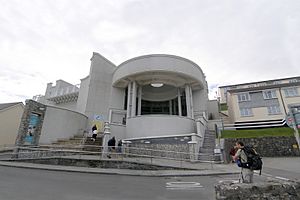
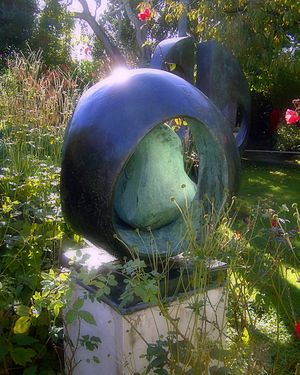
Since the 19th century, Cornwall's beautiful scenery and bright light have attracted many artists. The Newlyn School of artists was active around the turn of the 20th century. Later, famous modernist artists like Ben Nicholson and Barbara Hepworth lived in St Ives. You can see much of this art at Tate St Ives.
Local TV news is provided by BBC South West and ITV West Country. Radio stations like BBC Radio Cornwall and Pirate FM broadcast across the county.
Music
Cornwall has a strong folk music tradition. It's known for unique traditions like the Furry Dance in Helston and the Obby Oss in Padstow.
Like other old mining areas in Britain, Cornwall still has many male voice choirs and brass bands. Cornwall has about 40 brass bands, including the award-winning Camborne Youth Band.
Cornish musicians often take part in inter-Celtic festivals, and Cornwall hosts its own, like the Lowender Peran folk festival in Perranporth. Famous musicians like Richard D. James (Aphex Twin) and Roger Taylor from Queen grew up in Cornwall.
Literature
Cornwall's rich history and dramatic landscapes have inspired many writers.
Famous Authors and Books
Arthur Quiller-Couch lived in Fowey, and his novels are often set in Cornwall. Daphne du Maurier lived near Fowey, and many of her famous novels like Jamaica Inn and Rebecca are set in Cornwall. She also wrote The Birds, which was made into a famous film by Alfred Hitchcock.
The Poldark series by Winston Graham is set in Cornwall. J. K. Rowling's Harry Potter and the Deathly Hallows has a part that takes place in Cornwall. Nobel Prize-winning novelist William Golding was born in St Columb Minor.
The children's book The Mousehole Cat by Antonia Barber is set in the Cornish village of Mousehole and is based on the legend of Tom Bawcock.
Poetry
The late Poet Laureate Sir John Betjeman loved Cornwall, and it appears often in his poems. He is buried in a churchyard there. Charles Causley and A. L. Rowse were also well-known Cornish poets. The famous poem "For the Fallen" was written by Laurence Binyon on the cliffs between Pentire Point and The Rumps.
Other Works
In the Middle Ages, Cornwall produced many passion plays, like the Ordinalia. These plays are important because they give us valuable information about the Cornish language.
The fairy tale Jack the Giant Killer also takes place in Cornwall.
Sports
The main sports played in Cornwall are rugby, football, and cricket. Truro athletes have won medals in fencing at the Olympics and Commonwealth Games. Surfing is very popular, especially with tourists.
Rugby Football
Rugby union is a very popular sport in Cornwall and is strongly linked to Cornish identity. Cornish rugby players are known for being strong and independent.
Cornwall also has its own traditional sports. These include Cornish wrestling, which is similar to Breton wrestling, and Cornish hurling, a type of medieval football played with a silver ball. Cornish wrestling is Cornwall's oldest sport and has been taken around the world by Cornish miners.
Surfing and Watersports

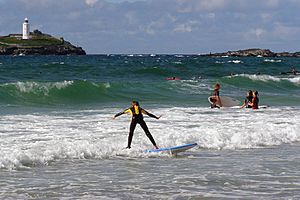
Because of its long coastline, many water sports are popular in Cornwall, especially sailing and surfing. Places like Bude and Newquay offer some of the best surfing in the UK. Pilot gig rowing has been popular for many years, and the World Championships are held every year on the Isles of Scilly.
Fencing
Even though Cornwall has a smaller population, it has had great success in fencing. In 2014, half of the men's Great Britain fencing team were from Truro Fencing Club, and three Truro fencers competed in the 2012 Olympics.
Cuisine
Cornwall has a rich food heritage. Being surrounded by the sea, it has lots of fresh seafood. Newlyn is one of the biggest fishing ports in the UK. Famous chefs like Rick Stein have fish restaurants in Padstow because of the great seafood. One unique local fish dish is Stargazy pie, which has fish heads sticking out of the crust!
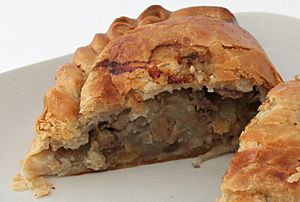
Cornwall is probably most famous for its pasties, which are savoury pastries. Today, pasties usually have beef, onion, potato, and swede inside. Historically, they had many different fillings, including sweet ones like jam or fruit. Pasties are often called oggies locally.
The wet climate and soil in Cornwall are perfect for growing grass for dairy farming. This leads to Cornwall's other famous product: clotted cream. This cream is used in many local treats like Cornish fudge and ice cream. Cornish clotted cream has special legal protection, meaning it can only be made in Cornwall.
Other local cakes and desserts include Saffron cake, Cornish heavy cake, and Cream tea. Many types of beers are brewed in Cornwall, and there's also some local wine, mead, and cider production.
Emergency Services
- Devon and Cornwall Police
- Cornwall Fire and Rescue Service
- South Western Ambulance Service
- Cornwall Air Ambulance
- HM Coastguard
- Cornwall Search & Rescue Team
- British Transport Police
Economy of Cornwall
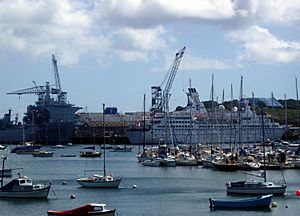
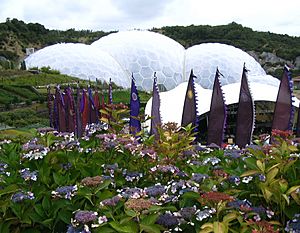
Cornwall is one of the less wealthy parts of the United Kingdom in terms of average income. However, some coastal areas have high house prices, often bought by retired people or for second homes.
Historically, tin mining and later copper mining were very important. The tin trade was so important that miners were given special rights. In the mid-19th century, tin mining declined. Other industries like china clay production, fishing, and farming have also become less important since the 1960s. Today, the old mine workings are a World Heritage Site. The Camborne School of Mines is still a world-leading centre for mining studies. China clay extraction is still an industry, but it employs fewer people now.
In 2016, a company bought the South Crofty tin mine with the goal of reopening it.
Tourism
Today, Cornwall's economy relies heavily on tourism, which makes up about a quarter of its economy. In 2011, tourism brought £1.85 billion into Cornwall. Cornwall's unique culture, amazing scenery, and mild climate make it a popular place to visit. It has many miles of beaches and cliffs, and the South West Coast Path goes all around both coasts. Other attractions include moorland, gardens, museums, and historic sites. Five million tourists visit Cornwall each year, mostly from within the UK.
The Eden Project near St Austell has been a huge success, attracting many visitors. In 2018, Cornwall saw a big increase in visitors, partly due to social media, which caused some traffic and safety issues in coastal areas.
Internet and Aerospace
Cornwall is a key point for the internet because many fast undersea fibre optic cables land here. The Superfast Cornwall project in 2015 connected 95% of homes and businesses to high-speed internet.
The county's newest industry is aviation. Newquay Airport is home to a growing business park called Aerohub. Spaceport Cornwall, a space launch facility, has also been set up at Newquay, working with the Goonhilly satellite tracking station.
Population and Education
Demographics
In the 2011 census, Cornwall's population was 537,400. Most of the population (95.7%) is White British. Cornwall has a relatively high number of retired people, with 22.9% of its population being of pensionable age. This might be because Cornwall is a popular place for retirement, and some younger people move away for more job opportunities.
Education
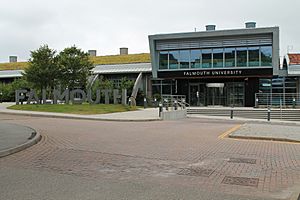
Over 10,000 students attend Cornwall's two universities: Falmouth University and the University of Exeter. Falmouth University focuses on creative industries and arts. The University of Exeter has campuses in Truro and Penryn, which it shares with Falmouth. The Penryn campus has departments like the Centre for Ecology and Conservation.
Cornwall has a comprehensive education system with 31 state and eight independent secondary schools. There are also three further education colleges: Truro and Penwith College, Cornwall College, and Callywith College. Many villages and towns also have primary schools.
Images for kids
-
Mên-an-Tol, an ancient stone monument
-
The ancient Hundreds of Cornwall
-
St Michael's Mount in Marazion
-
Truro, Cornwall's administrative centre and only city.
-
The red-billed chough (Pyrrhocorax pyrrhocorax pyrrhocorax), a bird that was once common in Cornwall.
-
Tate Gallery at St Ives
-
Artwork in the Barbara Hepworth Museum in St Ives
-
"FOR THE FALLEN" plaque with the Rumps promontory beyond
-
Remains of Tintagel Castle, believed to be King Arthur's birthplace
-
The world pilot gig rowing championships take place annually in the Isles of Scilly.
-
Cornwall's north coast is known as a centre for surfing.
-
A Cornish pasty
-
Falmouth Docks, one of the world's largest natural harbours
-
The Eden Project near St Austell, a major tourist attraction
-
Levant Mine in St Just Mining District
-
Falmouth University, Penryn
See also
 In Spanish: Cornualles para niños
In Spanish: Cornualles para niños



